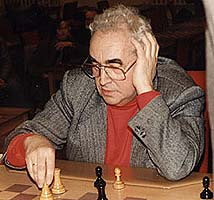
|
GM Mark Taimanov
annotates the games of the 13th round:
|
Up to 4 p.m. there happened only one event, but very important one - Anand and Sokolov on the 14th move have agreed for a quick draw. It looks like Anand told to his pursuers: "I guaranteed the 1st place for myself, so now try to keep my company!" And of course now everyone paid attention to the duels Kramnik-Leko and Svidler-Adams .
In the first one of them the events develop slowly and without any surprises. Contenders are playing one of the well-known variations of Queen Indian, where White has a more free space for his pieces and position of Black is rather passive, but very solid. It seems that Leko has no ambitious plans for today.
The game is played with some activity of White, but Black has a defensible position. Kramnik acts in his favourite style, after some regroupnig he is pressing on isolated d5-pawn. Leko is trying to simplify position as far as possible.
To the 32nd move Leko could exchange his weak pawn for a White's flank pawn, but the activity of White remained and there are still many problems for Leko to get a draw.
It's rather paradoxically, but the most important trump of Kramnik was the opposite Bishops. Usually it's the neutralized factor, but if the heavy pieces are on the board then it's one of the attacking factor, since the active side has an extra piece in attack. Leko sacrificed the pawn to exchange Queens and then his chances to save himself became higher. And he could do it by exchanging the Rooks with the help of a little tactical operation with the temprorary Rook sacrifice. Very important for final standings draw. Well, the round was very dramatical and interesting as well as the whole tournament.
The game Svidler-Adams is proceeded more animatedly. Here for 1.5 hours contenders have played 20 moves. Although the opening part in Rui Lopez is worked out very far and usually first moves here are played very quickly. In fact the first clash happened on the 17th move only - 17...b4. Adams agrees to give up the flexibilty of his pawn structure for an activity on his pieces. The struggle here promises to be interesting, but the perspectives of White look more preferable though.
The expectations of interesting midgame did not come true. Black's activity was a full compensation for a abundance of pawn "islets" in his camp. And after simplifications contenders agreed for a draw. So, Adams withdrew his candidature to compete with Anand for the 1st place.
The other games are not so important from the sportive point of view. But all the contenders in all probability are in a fighting mood.
Well-known in theory variation of Petroff defence was tested one more time in the game Shirov-Bologan . Up to 18 th move the game followed known canons. As usually White has some initiative here, but rarely who could use it practically. Bologan's novelty 18...Ne7 instead of 18...Rcd8 hardly could change the estimation of position since Shirov by natural manoeuvres could get some advantage in the center. Only the timely transfer of Queen from Q-side for the route a5-a6-c8-d7 closer to his forces could help to consolidate his position somehow. But even after sufficient simplifications - after exchange of 4 Rooks position of Black was difficult. 2 White's Bishops and the possibility to create the passed pawn in the center determined good perspectives for White. But then happened something strange, the impulsive moves 34.Qxd5 and especially 35.Be4? allowed Bologan to makr his pieces more active and to create the threats to King of White. The roles have changed and Shirov got into attack and lost the game offensively.
The game Zhong-Van Wely played very animatedly, but with a lot of mistakes. Position changed very often. At the end the ending with an extra pwan at White appeared. But due to the opposite Bishops it was not sufficient to play for a win.
After yesterday's impressive success Topalov was in very aggressive mood and today. But as it turned out his today's target became simplier than it was possible to expect. Timman to my great surprise played opening as doomed, very passively. In the interval of 13 and 20 moves he allowed his contender to seize all the board. His attempts to repel the attack by transfering to ending were necessary, but not enough. Even in ending his position was hopeless. By technically exact play Topalov won several white pawns and forced Timman to resign.
Right from the first moves contenders in the game Bareev-Akopian competed in neglect of classical opening principles. Just look for example at moves 5...Qc7 with following Qb6, or 7.g3 and then 9.g4! But if the chessplayers have a rich imagination then even such opening strategy leads to the interesting positions. In any case after pawn sacrifice (16.g5) with following opposite castlings the game became sharp and instructive. It seemed that after 24.f5 attack of White looks irresistible, but by piece sacrifice Akopian repelled direct threats and created active counter-play. I have to justice to Bareev who resolved to give back the piece to struggle for an initiative. He concentrated all his pieces on the K-side and using the strength of his Bishops drove back Black's forces. Then he forced the transfer to ending where his positional advantage became decisive. Despite of stubborn defence Akopian had to resign. Very engaging and original skirmish!